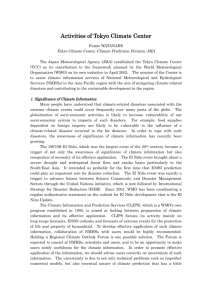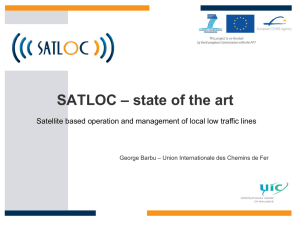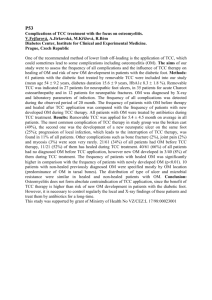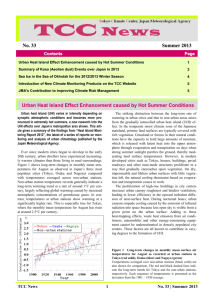Doc - WMO
advertisement
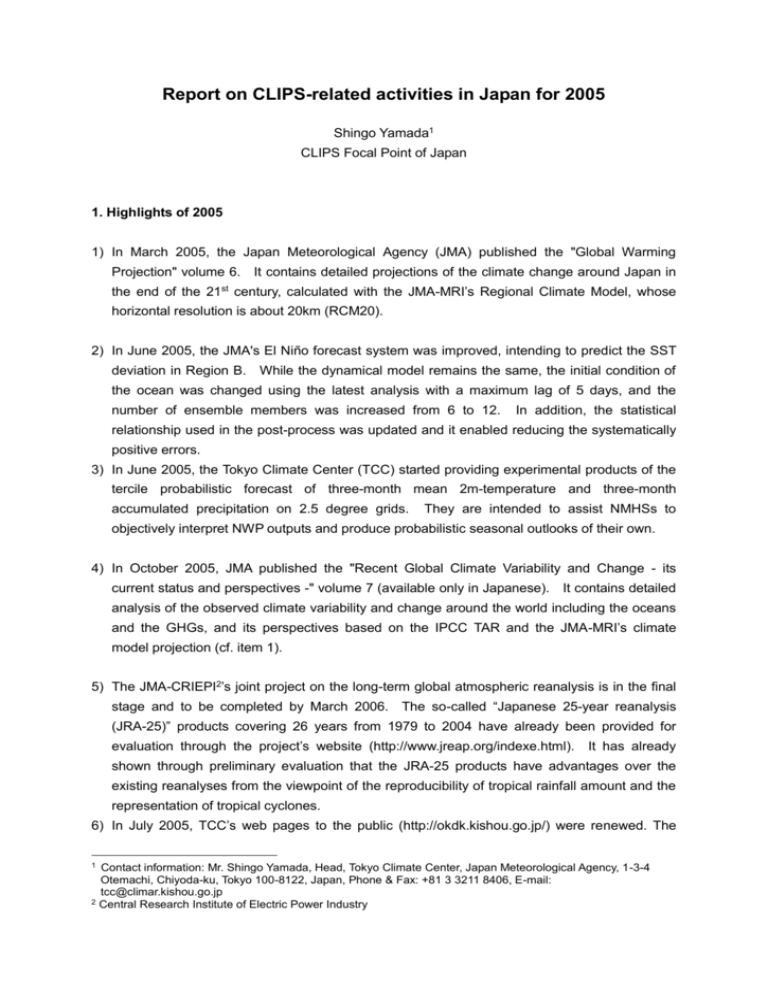
Report on CLIPS-related activities in Japan for 2005 Shingo Yamada1 CLIPS Focal Point of Japan 1. Highlights of 2005 1) In March 2005, the Japan Meteorological Agency (JMA) published the "Global Warming Projection" volume 6. It contains detailed projections of the climate change around Japan in the end of the 21st century, calculated with the JMA-MRI’s Regional Climate Model, whose horizontal resolution is about 20km (RCM20). 2) In June 2005, the JMA's El Niño forecast system was improved, intending to predict the SST deviation in Region B. While the dynamical model remains the same, the initial condition of the ocean was changed using the latest analysis with a maximum lag of 5 days, and the number of ensemble members was increased from 6 to 12. In addition, the statistical relationship used in the post-process was updated and it enabled reducing the systematically positive errors. 3) In June 2005, the Tokyo Climate Center (TCC) started providing experimental products of the tercile probabilistic forecast of three-month mean 2m-temperature and three-month accumulated precipitation on 2.5 degree grids. They are intended to assist NMHSs to objectively interpret NWP outputs and produce probabilistic seasonal outlooks of their own. 4) In October 2005, JMA published the "Recent Global Climate Variability and Change - its current status and perspectives -" volume 7 (available only in Japanese). It contains detailed analysis of the observed climate variability and change around the world including the oceans and the GHGs, and its perspectives based on the IPCC TAR and the JMA-MRI’s climate model projection (cf. item 1). 5) The JMA-CRIEPI2’s joint project on the long-term global atmospheric reanalysis is in the final stage and to be completed by March 2006. The so-called “Japanese 25-year reanalysis (JRA-25)” products covering 26 years from 1979 to 2004 have already been provided for evaluation through the project’s website (http://www.jreap.org/indexe.html). It has already shown through preliminary evaluation that the JRA-25 products have advantages over the existing reanalyses from the viewpoint of the reproducibility of tropical rainfall amount and the representation of tropical cyclones. 6) In July 2005, TCC’s web pages to the public (http://okdk.kishou.go.jp/) were renewed. The 1 Contact information: Mr. Shingo Yamada, Head, Tokyo Climate Center, Japan Meteorological Agency, 1-3-4 Otemachi, Chiyoda-ku, Tokyo 100-8122, Japan, Phone & Fax: +81 3 3211 8406, E-mail: tcc@climar.kishou.go.jp 2 Central Research Institute of Electric Power Industry TCC website has been updated periodically and the following new items are now available; “Global Warming Projection. Vol.6”, “Climate Change Monitoring Report for 2004”, “TCC News” and some other current topics, such as “the summary of Bai-u season in Japan” and “the Report on the status of the Antarctic ozone hole in 2005”. 2. Climate monitoring and prediction services in Japan The Climate Prediction Division (CPD) of JMA is responsible for official services related to climate monitoring and prediction in Japan. CPD prepares several kinds of climate related products and disseminates them to the public. Those products include monitoring reports on the global climate and extreme climate events, monitoring reports on the global climate system, El Niño diagnosis and outlook, long-range forecasts, and the global warming projection. 2.1 Monitoring of the global climate and extreme climate events CPD monitors the current status of the global climate using CLIMAT and SYNOP reports from NMHSs through the WMO Global Telecommunication System (GTS). After quality-checked, surface temperature and precipitation data are assembled to analyze and assess extreme climate events around the world. In addition, press reports are routinely monitored to maintain the database on weather-related disasters in the world such as floods, droughts, forest fires and severe storms. The global maps of mean temperatures, accumulated precipitation amounts, and their anomalies are prepared weekly, monthly and seasonally and the reports on extreme climate events around the world are issued with brief description on disastrous events. 2.2 Monitoring of the global climate system CPD monitors the current state of the global climate system focussing on atmospheric circulation, convection, ocean and snow/ice coverage based on the analyses of the objective data assimilation system and satellite observations. These monitoring results are compiled as the “Monthly Report on Climate System” and issued every month since 1986. The Reports provide long-range forecasters and climate researchers with useful information about the cause of the extreme climatic events and analyzed long-term climate trends. 2.3 El Niño diagnosis and outlook CPD issues the report on the current status and outlook of El Niño on a monthly basis. It contains the diagnosis of oceanic and atmospheric conditions of the equatorial Pacific and six-month outlook for El Niño and La Niña events. A global ocean data assimilation system is operated to monitor the global sea temperatures while a coupled ocean-atmosphere global circulation model is operated to predict the sea surface temperatures in the equatorial Pacific. 2.4 Long-range forecast CPD issues four kinds of long-range forecasts: one-month forecast, three-month outlook, warm season outlook and cold season outlook, as summarized in Table 1. Forecasts of individual elements are presented with probabilities in three categories: below normal, near normal and above normal. Climatological likelihood of falling within each category is 33.3 % according to the statistics for the period of 1971-2000. An ensemble prediction system was introduced to one-month forecast in 1996 and three-month outlook and warm/cold season outlook in 2003. Table 1 Outline of long-range forecasts issued by JMA Warm (Mar – Aug)/ One-month forecast Three-month outlook Cold (Oct – Feb) season outlook th Date of 25 February Every Friday 25th of every month Issue / 25th September Lead time 1 day About 1 week About 2 or 3 months Probabilistic forecasts in Probabilistic forecasts in Probabilistic forecasts in three categories: three categories: three categories: Monthly mean temp. 3-month mean temp. 3-month mean temperature Monthly precipitation 3-month precipitation (Jun.-Aug./Dec.-Feb.) Main Monthly sunshine 3-month snowfall+ 3-month precipitation Contents duration Monthly mean temp. (Jun.-Aug./Dec.-Feb.) Monthly snowfall+ Monthly precipitation 3-month snowfall+ Weekly mean temp. (Dec.-Feb.) (1st, 2nd, 3rd - 4th week ) Precipitation during Bai-u (Jun.-Jul. or May-Jun.) Method Dynamical Dynamical/ Statistical Dynamical/ Statistical + Snowfall forecasts are issued only for the areas along the Japan Sea. 2.5 Dissemination of climate information Climate information produced by CPD is delivered to the general public through the official web site of JMA, mass media, printed matters and CD-ROMs. It is also provided directly to the specific users such as government authorities concerned. To promote effective usage of climate products by users, the JMA headquarters and its local offices hold press conferences to give explanation of the information when issuing the three-month outlook, the warm/cold season outlook and the El Niño outlook. They also hold regular meetings on climate information for central and local government users. The meetings aim at providing the users with the latest information on the climate-related services of JMA and finding out their needs and requirements on the climate information. The meetings play a major role in keeping close relations between JMA and the users. 3. Activities of Tokyo Climate Center (TCC) TCC is a section in the CPD/JMA established in April 2002, which is responsible for providing National Meteorological and Hydrological Services (NMHSs) in the Asia-Pacific region with basic climate data and products, and assists NMHSs with enhancing climate-related activities through training and technical assistance. The following products are available through the TCC website (http://cpd2.kishou.go.jp/tcc/) except grid point value (GPV) data of the ensemble prediction, users of which are restricted to NMHSs of the WMO Members. i) Global surface climate monitoring ii) Global climate system monitoring iii) El Niño monitoring and outlook iv) One-month, three-month and six-month ensemble prediction v) Global warming projection vi) Long-range forecast over Japan vii) Training modules and presentations viii) Press release and “TCC News” There are several products that have been newly added to the TCC website since the beginning of 2005. They include the objectively analyzed GPV data of atmospheric circulation in March 2005, the experimental products of the tercile probabilities of three-month mean 2m-temperature and three-month accumulated precipitation in June 2005, the “global warming projection volume 6” in July 2005, and a quarterly news letter called “TCC News” in July 2005. Several presentations, which were given at some international meetings and conferences, were also added to the TCC website to provide the users with our on-going development activities. TCC is planning to improve data and products available from the TCC website in the future. 4. Liaison with users for improving climate information Japan experienced extremely cool summer in 2003 and had a poor crop due to extremely low temperature and shortage of sunshine especially in the northern Japan. The economic damage of crop production in the summer 2003 reached to nearly four billion US dollars. To the contrary, the summer of 2004 was record-breaking hot in Japan, and lots of typhoons came to Japan and caused enormous damage. Those experiences urged us to develop the climatic early warning system for the extreme climate events such as cool/hot summer, so as to prevent or mitigate socio-economic damage. In order to investigate the users’ needs and requirements, CPD started dialogues with electric power industry and agriculture sector. It has been clarified that they need more area-specific temperature forecasts up to 2 weeks ahead, and that we should issue forecast in a proper timing for their usage. CPD has set out to develop tailored products such as the early warning of extreme climate events under the close liaison with specific users. CPD is investigating an objective method producing probabilities of exceeding arbitrary threshold at specific points. Some preliminary products are planned to be produced by the end of FY2006. 5. Training activities JMA has been conducting a training course in meteorology for developing countries every year since 1973 as one of the training courses provided by the Japan International Cooperation Agency (JICA), a Japanese official organization implementing international development assistance. In 2005, the course was held from 14 September to 16 December at the JMA headquarters and related institutions, attended by eight participants from Algeria, Bangladesh, Eritrea, Fiji, Indonesia, Kiribati, Laos, and Senegal. The course is focused on operational use of numerical weather prediction, satellite meteorology and climate information. Two weeks were allocated for climate information, and CPD delivered lectures on climate system monitoring, long-rang forecast, El Niño outlook and global warming projection and provided a practical training on utilization of the GPV data derived from the JMA’s ensemble prediction system. Some climate scientists and experts were invited as lecturers from the International Research Institute for Climate and Society in USA, the University of Tokyo and the Japan Agency for Marine-Earth Science and Technology. 6. Activities on regional level Responses to the “Questionnaire on requirements for the establishment of Regional Climate Centres (RCCs) in RA II” were analyzed in 2004. Considering this analysis, the thirteenth Session of RA II held at Hong Kong/China in December 2004 recommended immediate implementation of RCC activities through establishing the RA-II RCC network of multiple multifunctional centres complemented by specialized centres loosely coordinated by an oversight committee. Each of multifunctional centre for RCC is requested to conduct most of “Operational function”, “Co-ordination function”, “Data services function”, “Training and capacity building function” and “Research and development function”. Each of specialized centre is requested to conduct at least one of the five functions mentioned above. The RA-II RCC network on a pilot basis will be launched in early 2006. TCC/CPD plans to apply for one of the multifunctional centres to contribute to the regional activities on climate information and prediction services.
